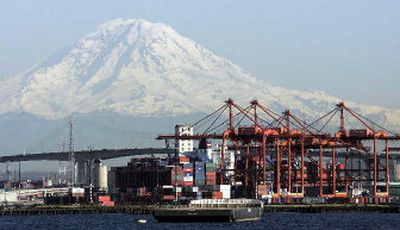Security card riles transport workers

WASHINGTON – Truck drivers, longshoremen and mariners will have to pay as much as $159 for a high-tech identity card that will grant them access to U.S. ports.
Groups representing truckers and longshoremen said the fee is too high and will force some workers – especially truck drivers – to quit their jobs.
Some workers will have to buy the cards as soon as March. But a time has not been specified for port operators and ship owners to buy the equipment that reads the cards, according to a rule announced Wednesday by the Homeland Security Department.
The agencies issuing the cards – the Coast Guard and Transportation Security Administration – have yet to test card readers and decide on specifications.
TSA chief Kip Hawley said the government’s main interest is port security. Until card readers are installed, Coast Guard patrols will conduct random checks of the cards with handheld devices at ports, he said.
Todd Spencer, executive vice president of the Owner-Operator Independent Drivers Association in Grain Valley, Mo., described the fees as “really high” for a program “that isn’t even functional.” The group represents 148,000 drivers.
“It’s going to be another reason that drivers are simply going to say, ‘Phooey, I’m not going to get any of it,’ ” Spencer said.
The cards were ordered by Congress in 2002 to strengthen security at seaports, which are considered vulnerable to terrorist attacks.
The project stalled, however. Congress passed a port security bill in October that included a requirement that rules for the new card be written by Jan. 1.
The Transportation Workers Identity Credential will be issued initially to 750,000 port workers who pass government background checks.
The card will contain the holder’s photograph and name, an expiration date and a serial number. An integrated circuit chip will store the holder’s fingerprint template, a PIN chosen by the individual and unique identifying information.
Steve Stallone, spokesman for the San Francisco-based International Longshore and Warehouse Union, said the cards at first would work like the cheap photo IDs already in use at ports.
“We’re going to be paying $139 to $159 and we don’t know how they work?” Stallone said.
Hawley said the fee was reasonable for a card that is good for five years and includes high-tech identification verification and a security threat assessment. Drivers who have had background checks, either because they carry hazardous material or cross the border, will pay less, he said.
“It’s pretty hard to say, ‘I can’t afford $30 a year for a professional credential,’ ” Hawley said.
Kevin Hayes, vice president for Long Beach Container Terminal Inc., at the Port of Los Angeles/Long Beach, said the program could make ports more efficient.
“As a uniform credential, it will speed things up because there will be a lot less thinking involved – eventually,” he said.
Ultimately, as many as 6 million transportation workers in rail yards, airports and seaports will have to buy the card to gain access to secure areas.
Last April, Homeland Security Secretary Michael Chertoff announced that seaport workers would be checked for links to terrorism and to ensure they are legal residents. Yet only port workers and longshoremen have been checked so far.
Hawley said the TSA has conducted background checks of truck drivers who have applied for credentials to carry hazardous materials. Fewer than 1 percent failed to pass the checks, he said. “We don’t have any apology for requiring a legal residency,” Hawley.